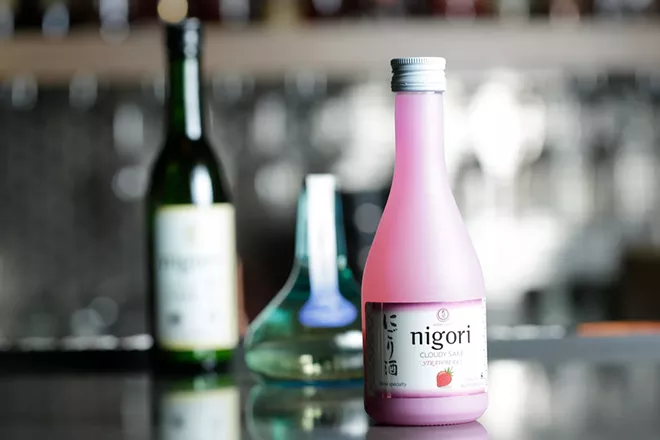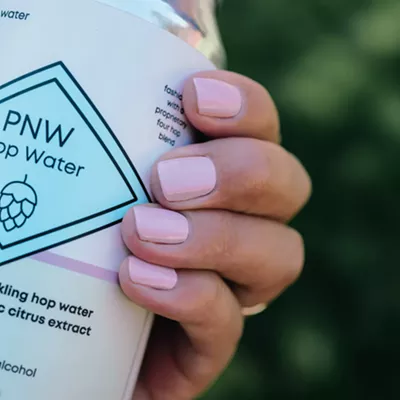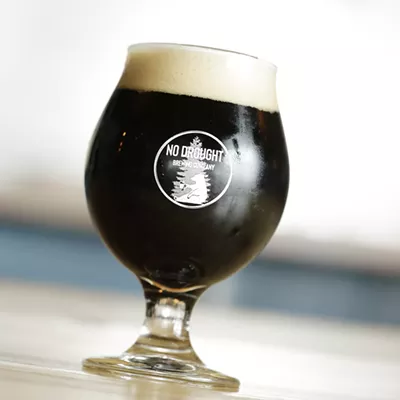Question: Which alcoholic beverage is made like beer and wine through fermentation, yet has qualities more similar to distilled spirits? It offers complex flavors from dry to sweet and fruity to floral, yet can register between 15 to 18 percent alcohol by volume (like a port wine) and has a longer shelf life once opened than beer, which goes flat, or wine, which becomes salad dressing. And while warm beer can be gross, and only select wines are typically chilled, this versatile beverage can be served warm, cool, and even ice cold like a cocktail.
Sake, sometimes referred to as rice wine, was exported several thousand years ago from China into Japan, the country typically associated with sake. It's basically four ingredients: rice, water, yeast and kji, a fungus used to ferment rice and which sake brewers need for its alchemy of alcohol production.
"It's similar to beer brewing, except it's done [all] at the same time in the same tank," says Marcus Pakiser, a former sake brewer I spoke with by phone from his home in Oregon.
"The fifth ingredient is brewer's alcohol for flavor and aroma," says Pakiser, who notes that differences in rice milling and whether alcohol is added account for the main varieties of sake, such as junmai (no added alcohol). Sake can also be "cloudy," minimally filtered in a process that leaves some rice particles suspended in the final product, like the silky sake called nigori.
Restaurants serving Japanese food are where many diners first experience sake, typically served in small ceramic cups, either warm or cold, depending on the sake. And "sake bombs," which are a shot of sake dropped into a beer, are still popular among partiers.
Knowing that, Sandpoint-based restaurateur Junior Solis offered beer, wine and what he called "saketinis" at Oishii in 2007, first sparking many locals' interest in sake's versatility. It seemed a clever way to offer cocktail-like drinks despite Idaho's nonsensical liquor licensing.
"By blending a variety of unfiltered, sparkling and junmai sake with local fruit and exotic purees," says Solis, "we were able to take sake from a hot wine you take shots of to a delicious cocktail you can enjoy."
That was 15 years ago, and Solis has since retired. His saketinis are still outliers in the pantheon of beverage options. We recently found two places, both in Coeur d'Alene, however, that offer sake cocktails: Try the sake mule ($8) at Syringa Japanese Cafe & Sushi Bar, or Kaiju Sushi & Spirits' creamsicle ($8) with nigori sake. However, the lone Spokane restaurant we found offering sake-based cocktails stopped doing so once its full bar license came through.
Instead, you might just have to ask for one at Umi Kitchen & Sushi Bar, where mixologist Phil Lerdal made us his cucumber saketini. Lerdal says he doesn't get many requests for sake cocktails.
"Our sake drinkers, they really like that traditional sake" experience, he says.
Umi typically stocks a nigori, the drier, cloudy sake, something that can be served warm, "and a few fun flavors like sparkling peach," Lerdal says. "It's a mixture of affordability, high quality and brand names."
At Umi, Lerdal uses Ozeki, from the first Japanese sake brewer to establish a facility in the United States, in 1979. It along with Gekkeikan and Sho Chiku Bai are fairly common brands and available at many grocery stores. And although the U.S. is the top importer of Japanese sake, the drink itself remains a niche beverage.
Sake industry expert Pakiser would like to change that.
"There are so many misconceptions about sake," says Pakiser, who moved to Japan in 1988 to teach English, immersed himself in the culture and met his future wife. When Pakiser relocated to Colorado in the '90s, a sake brewer looking for someone fluent in Japanese hired Pakiser to learn brewing.
Regarding how sake is served, for example, Pakiser says it's meant to be savored, not slammed. The little cups, called ochoko, and the carafe from which it's poured, tokkuri, are part of the ritual. Pouring sake for each other is a social way of drinking, he says.
"That's just a sign of gratitude, and it's a sign of friendship," Pakiser says.
Another myth: Sake only goes with certain foods, a misnomer that similarly hampered wine and beer appreciation until the culinary industry and consumers realized otherwise.
"It's only our minds that, say, 'Oh no, you can't have sake with cheese, or you can't have sake with pizza.' I've proven over and over the last 30 years that you can have mac and cheese and sake, probably one of the best pairings on the planet," Pakiser says.
Many menus include numbers next to each type of sake — a positive number indicates dryness, while a negative number equates to sweetness. That's misleading, says Pakiser, who counts himself among the misled.
"Some years ago, I decided that I only liked dry sakes. I would never drink anything that was less than a plus five. I was an idiot. I missed out on so many great sakes because I just decided on some arbitrary number that I had to have something plus five or more. And that was a very big mistake on my part," Pakiser says. "And that's how you learn things, right?"
What he'd like to see is menu descriptions like "any sake within this section is dry and earthy, or umami-driven sake. And the next section can be fruity and floral sake or smooth and elegant sake," Pakiser says.
Pakiser would also like to see more places selling sake by the glass — versus the bottle — and doing sake flights (both Syringa and Kaiju offer them), especially since it doesn't oxidize like wine.
By Phil Lerdal, Umi Kitchen & Sushi Bar
1 ounce Tito's vodka
1/4 ounce Ozeki sake
1/4 ounce St. Germain elderflower liqueur
1 inch cucumber, muddled
1/2 lime, muddled
Splash of lime juice
Pour into shaker filled with ice, shake, strain into martini glass and garnish with cucumber slice
"You don't have to drink it in a day or two," he says. "I have bottles in my fridge that have been open for nine months. No problem," says Pakiser, whose advocacy for the beverage has earned him worldwide recognition.
In 2015 the Japan Sake Brewers Association Junior Council designated Pakiser as a Sake Samurai — there are only about 80 of them total — for his dedication to sake tradition and education.
Knowing a Sake Samurai was helpful for Northern Quest Resort & Casino's Assistant Director of Food and Beverage Michael Miho when developing the sake menu for East Pan Asian Cuisine.
The restaurant, which opened in May 2022, has four sakes on the menu, including Dry Mountain ($9.25), imported from Fuji Brewing Company, founded back in 1778, and currently being led by the 13th generation of the same family.
That, says Miho, appeals to him.
"I am looking for the story, the provenance behind the sake, even more than what classification it is, what price point," Miho says.
The story "always comes down to an individual house, a story of family, a journey. And it's everything that they've done for 100 or more years, multiple generations of just focusing on this one product. And it's beautiful." ♦

























